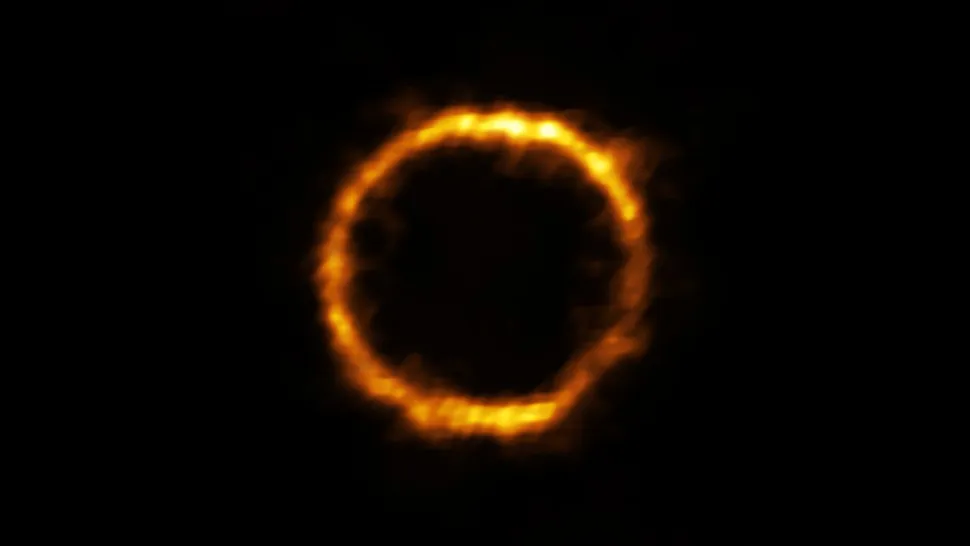
Posted on 03/08/2023 8:02:39 AM PST by Red Badger
'We found this galaxy to be super-chemically abundant, something none of us expected.'

A gravitationally lensed view of a ring-shaped slice of the galaxy SPT0418-47, as seen by the ALMA array in Chile. Recent observations by NASA's James Webb Space Telescope reveal that the galaxy has a satellite that's rich in star formation. A gravitationally lensed view of a ring-shaped slice of the galaxy SPT0418-47, as seen by the ALMA array in Chile. Recent observations by NASA's James Webb Space Telescope reveal that the galaxy has a satellite that's rich in star formation. (Image credit: ALMA (ESO/NAOJ/NRAO), Rizzo et al.)
New images from NASA's James Webb Space Telescope (JWST) have revealed that a well-known early galaxy has an overshadowed companion that is abundant with star formation.
JWST's initial target was SPT0418-47, one of the brightest dusty, star-forming galaxies in the early universe. Given it is an extremely distant galaxy — it lies about 12 billion light-years from Earth — its light is bent and magnified by the gravity of another galaxy in the foreground (located between SPT0418-47 and the space telescope), creating a near perfect circle called an Einstein ring.
Using the JWST, astronomers were able to get a clearer view of SPT0418-47 and spotted a curious blob of light shining near the galaxy's outer edge. As it turns out, the blob represents a companion galaxy previously overshadowed by the light of the foreground galaxy, according to a statement(opens in new tab) from Cornell University.
Related: 12 amazing James Webb Space Telescope discoveries
"We found this galaxy to be super-chemically abundant, something none of us expected," Bo Peng, lead author of the study and a doctoral student in astronomy at Cornell, said in the statement. "JWST changes the way we view this system and opens up new venues to study how stars and galaxies formed in the early universe."
Earlier observations of SPT0418-47 using the Atacama Large Millimeter/submillimeter Array (ALMA) in Chile contained hints of the companion, which, at the time, were interpreted as random noise, the researchers said.
Using the JWST, the researcher discovered that the companion galaxy, called SPT0418-SE, is within about 16,000 light-years of SPT0418-47. By comparison, the Magellanic Clouds — a pair of dwarf galaxy companions to the Milky Way — are located roughly 160,000 light-years away from us.
The close proximity of SPT0418-47 and SPT0418-SE suggests these galaxies are bound to interact or merge with one another eventually. In turn, this galactic pair could shed light on how early galaxies evolved into larger ones, given SPT0418-47 is believed to have formed when the universe was only 1.4 billion years old, according to the statement.
Interestingly, SPT0418-SE is believed to have already hosted multiple generations of stars, despite its young age. Both of the galaxies have a mature metallicity — or large amounts of elements like carbon, oxygen and nitrogen that are heavier than hydrogen and helium — which is similar to the sun. However, our sun is 4.5 billion years old and inherited most of its metals from previous generations of stars that were eight billion years old, the researchers said.
"We are seeing the leftovers of at least a couple of generations of stars having lived and died within the first billion years of the universe's existence, which is not what we typically see," study co-author Amit Vishwas, a research associate at the Cornell Center for Astrophysics and Planetary Sciences, said in the same statement.
"We speculate that the process of forming stars in these galaxies must have been very efficient and started very early in the universe, particularly to explain the measured abundance of nitrogen relative to oxygen, as this ratio is a reliable measure of how many generations of stars have lived and died," Vishwas said.
The new findings were published Feb. 17(opens in new tab) in the Astrophysical Journal Letters.
Follow us on Twitter @Spacedotcom(opens in new tab) or on Facebook(opens in new tab).
Join our Space Forums to keep talking space on the latest missions, night sky and more! And if you have a news tip, correction or comment, let us know at: community@space.com.
One Ring to Freak them ALL Ping!..............
Hmmm. With gravitational lensing, is there a chance Webb and Hubble are looking back at themselves?
“ ‘We found this galaxy to be super-chemically abundant, something none of us expected.’”
It used to be
Billions and billions of years ago
The Firmament
Yeah, Earth is the ONLY flat one inside a fishbowl, and orbital mechanics is pure fiction.
Find help.
🤪🤪🤪🤪🤪
Are you 5 years old?
After this they don’t even know if it is the “early” universe.
They know it is earlier of course but since they no longer have a coherent “start” time they don’t have a valid clock anymore.
Exactly.
None of the ‘new’ data fits their ‘models’.
They basically have to start all over again from scratch with a blank sheet of paper..............
There’s nothing like the universe to bring you down to earth.
Is that even possible?

Yes, it is.
Post of this day. I walked right into that without knowing. Well played!
Disclaimer: Opinions posted on Free Republic are those of the individual posters and do not necessarily represent the opinion of Free Republic or its management. All materials posted herein are protected by copyright law and the exemption for fair use of copyrighted works.